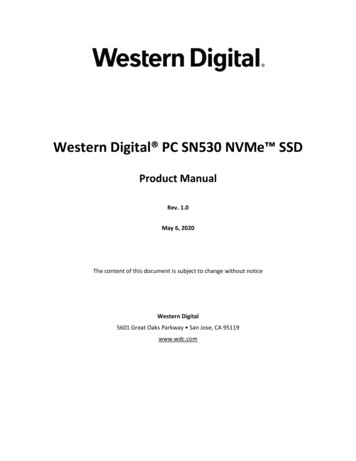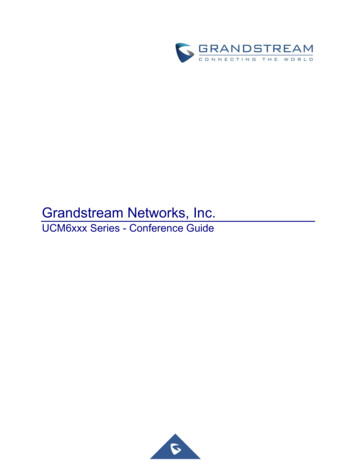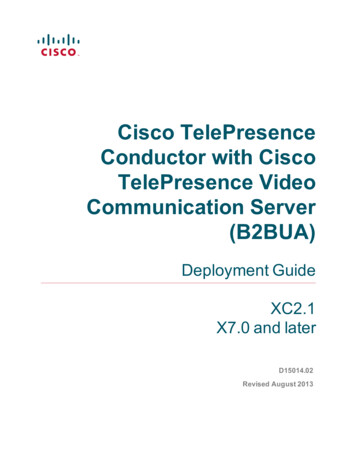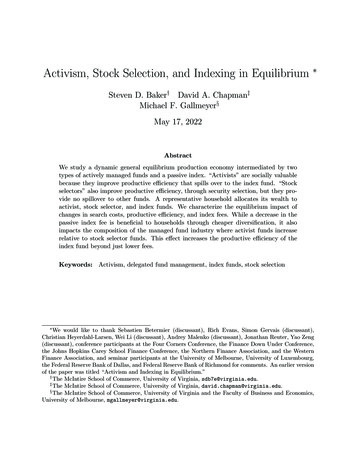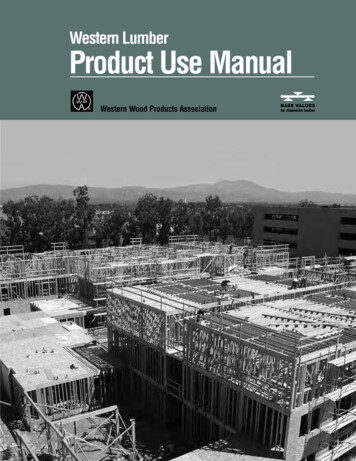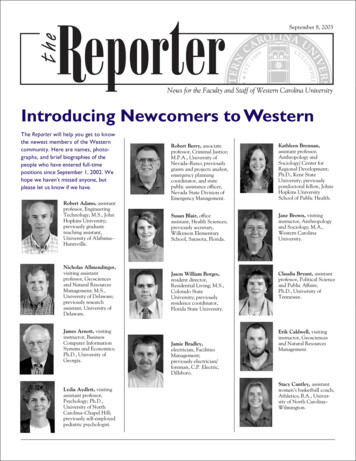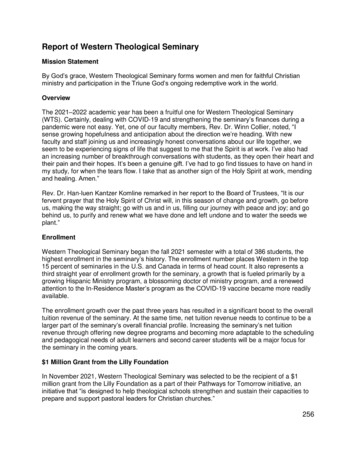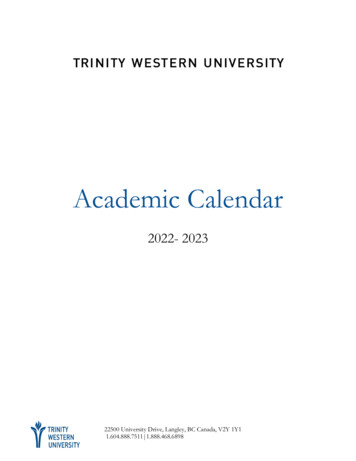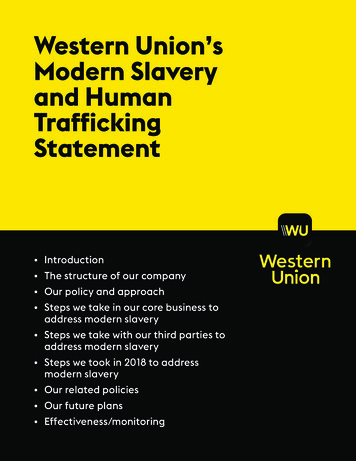
Transcription
199th 2YC3 Conference(Western)Old Wine, New Flasks:Chemical Education in the 21st CenturyArizona Western CollegeYuma, ArizonaNovember 9-10, 2012Program Chair:Exhibits Coordinator:Scott DonnellyFrancisco VillaThe Thinkerby Auguste zwestern.edu928.344.7590928.317.7080
Table of ContentsWelcome Letter Sponsors List .List of Exhibitors .Day-at-a-Glance Program ScheduleFriday, November 9 .Saturday, November 10 .Presentation Abstracts .Research Interests of Keynote Speakers Exhibitor Booth Layout .Photo of Exhibitor Booth Area .23456810172122
Dear Colleague/Friend:Welcome to Yuma, AZ and thank you for traveling to southwestern Arizona toparticipate in the 199th Two-Year College Chemistry Consortium (2YC3) conference hereat Arizona Western College (AWC). The conference has a full exhibitor and oralpresentation schedule for this two-day event.You've heard the saying- All work and no play makes Jack a dull boy. Though you'll bebusy during the two days attending a full agenda of thought-provoking presentationsgiven by two-year college and university chemistry faculty from around the countryand also checking out the educational products of and, perhaps doing business withexhibitors, it's our hope that you also will find some time to enjoy the numerous finedining experiences, historical sites, and spectacular landscape of the surroundingSonoran Desert ecosystem. If you have never seen the vastness of the Milky Way in allits glory, then you are in the right locale to take it in and have an out-of-this-worldexperience. A short drive out of Yuma into the "dark matter" of the desert is all it takesto experience first hand such majesty, such infinity. And best of all- it's FREE!In closing, we also hope that upon returning home you leave the conference meetinghaving made new friends and rekindled old friendships, have established new personalcontacts, and/or embarked on new educational collaborations. Chemistry educationlike chemistry itself- a highly hands-on and noble endeavor- is not done in isolation.Advances in chemical education and the exchange of ideas are- at the very core- aboutpeople. About people who envision the future not as others view it but rather as thoseiconic chemical educators who questioned the present so as to have answers for thefuture.Safe travels and we look forward to meeting you. Cheerio.Respectively,Scott Donnelly & Francisco Villa3
199th 2YC3 Conference Sponsors ListThe organizers of the 199th 2YC3 conference would like to thank the followingcompanies and individuals for their generosity in making this conference possible.Dr. Ian & Judy WatkinsonBruce & Debra GwynnThe organizers also would like to thank Wavefunction, Inc. for the generous donationof two Spartan Student and Odyssey Annual Site Licenses.4
List of Exhibitorswww.microlabinfo.comMicroLab Inc.1600 Ellis StreetSuite 1BBozeman, MT 59715Phone: (888)-586-3274Email: info@microlabinfo.comwww.aiinmr.comAnasazi Instruments, Inc.4101 Cashard Ave. #103Indianapolis, IN 46203Phone: (866)-494-9369Email: arning.comACS Office of Two-Year CollegesAmerican Chemical Society1155 Sixteenth St. NWWashington, DC 20036-4839(202)-872-6108 (office) (202)-833-7732 (fax)Email: 2YColleges@acs.orgSapling Learning2815 Exposition BlvdAustin, TX 78703Email: support@saplinglearning.comPhone: (512)-323-6565Fax: (512)-524-1124www.wwnorton.comW. W. Norton & Company500 Fifth AvenueNew York, NY 10110Email: amoyer@wwnorton.comPhone: (212)-790-7221Fax: (212)-869-08565
Conference ScheduleFriday, November 9, 20128:00 –5:00ExhibitsAS lobby (AS Agricultural Science building)8:00 –9:00Registration, Refreshments, and ExhibitsAS lobby9:00 –9:15College President’s Welcome and Opening RemarksGlenn Mayle, President, Arizona Western College3C Conference Center South Wing- Room 116A9:15 –10:00Keynote AddressFinding the way forward: Facing science education challenges in the 21st centuryPeter Morse, Santa Monica City College, Santa, Monica, CA3C Conference Center South Wing- Room 116A10:00 –10:25Refreshment Break and ExhibitsAS lobby10:30 –11:002YC3 General Membership MeetingJason Jadin, 2YC3 Chair, Rochester Community and Technical College, Rochester, MNAS 21511:05 –11:50Parallel Presentation SessionA.Spectroscopy can be visual, hands-on, quantitative, and affordable!John Amend, MicroLab, Inc., Bozeman, MTAS-112B.ACS: Partners in supporting excellence in two-year collegesAmina El-Ashmawy, Chair, ACS Two-Year College Advisory Board, Collin College,McKinney, TXAS-11311:55 –1:00Lunch Break3C Conference Center AWC Eatery or Local Restaurants(Also, please support the vendor's Exhibits in the AS Lobby)1:00 –2:35WorkshopResources for excellence and making positive changes: A collaborative project of 2YC3and the ACSTom Higgins, Harold Washington College, Chicago, ILCandice Campbell, Georgia Perimeter College, Dunwoody, GAAS-1146
1:00 –1:45Parallel Presentation SessionA.Research opportunities for community college studentsPaul Smolenyak, Yavapai College, Prescott, AZAS-112B.1:50 –2:35Power Point and POGIL, having it both waysJohn Trombley, Arizona Western College, Yuma, AZAS-113Parallel Presentation SessionA.Programs in the NSF Division of Undergraduate Education (DUE) that supportchemistry educationDavid R. Brown, Program Director, Division of Undergraduate Education, NationalScience FoundationAS-112B.Flipping the chemistry classroomLarry Eddy, Yavapai College, Prescott, AZAS-1132:35 –3:00Refreshment Break and ExhibitsAS lobby3:00 –3:45Parallel Presentation SessionA.Using visualization techniques in the chemistry classroomThomas Jose, Blinn College-Bryan Campus, Bryan, TXAS-112B.3:50 –4:35Parallel Presentation SessionA.An open discussion on dual enrollment in chemistryDoug Sawyer, Scottsdale Community College, Scottsdale, AZAS-112B.5:00–7:00Online Introductory Chemistry course: From conception to implementationLance Lund, Anoka-Ramsey Community College, Coon Rapids, MNAS-113Using GIS software to make periodic table diffusion cartogramsDan Weit, Nicolette Walano, and Thomas HigginsHarold Washington College, Chicago, ILAS-113Dinner Banquet and AddressStrange times on planet Earth? Transformation of the global environmentMalcolm Hughes, University of Arizona, Tucson, AZ3C Conference Center South Wing- Room 116A7
Conference ScheduleSaturday, November 10, 20128:30 –4:00ExhibitsAS lobby8:00 –8:55Registration, Refreshments, and ExhibitsAS lobby9:00 –9:45Opening SpeakerWouldn’t it be nice to understand solar devices? (A totally subjective and abbreviatedreport on where we are and what we can do to know more)Clemens Heske, University of Nevada Las Vegas and Karlsruhe Institute of Technology3C Conference Center South Wing- Room 116A9:50 –10:10Refreshment Break and ExhibitsAS lobby10:15 –11:00Parallel Presentation SessionA.Teaching how we think instead of what we knowVicente Talanquer, University of Arizona, Tucson, AZAS-112B.11:05 –11:50Tablet PC– Providing students easy access to course materialsLance Lund, Anoka-Ramsey Community College, Coon Rapids, MNAS-113Parallel Presentation SessionA.Chemistry of taste and smellTom Higgins, Harold Washington College, Chicago, ILJoann Um, Southwestern College, Chula Vista, CAAS-112B.Maintaining academic standards, rigor and experiences in the natural sciences in arural desert college systemPaul Haberstroh, Mohave Community College, Lake Havasu City, AZAS-11311:55 –1:00Lunch Break and ExhibitsAS lobby1:00 –1:45Parallel Presentation SessionA.Discussion of critical elements of competitive NSF grant proposals submitted tothe Division of Undergraduate Education (DUE)David R. Brown, Program Director, Division of Undergraduate Education, NationalScience FoundationAS-112B.Solving the right problem in STEM EdTech: Coursework, not textbooksThomas Murosky, Sapling Learning, Austin, TXAS-1138
1:50 –2:35Parallel Presentation SessionA.NMR as a quantitative toolDonald Bouchard, Anasazi Instruments, Indianapolis, INAS-112B.Using Online Homework in General ChemistryThomas Murosky, Sapling Learning, Austin, TXAS-1132:35 –3:00Refreshment Break and ExhibitsAS lobby3:00 –3:45Parallel Presentation SessionA.Chemistry of bread, emulsions, foams, and gelsJoann Um, Southwestern College, Chula Vista, CAThomas Higgins, Harold Washington College, Chicago, ILAS-112B.Relationship of approaches to studying metacognition and intellectual developmentof general chemistry studentsHenrietta Egenti, Tarrant County College, Hurst, TXAS-113From Calvin & Hobbes9
Abstracts of Oral Presentations199th 2YC3 ConferenceArizona Western CollegeNovember 9-10, 2012Friday, November 99:15-10:00am Opening Conference Address:Finding the way forward: Facing science education challenges in the 21st centuryPeter Morse, Professor of Physics, Santa Monica College, Santa Monica, CA; morse peter@smc.eduTwo-year college science faculty have always been asked meet a wide variety of educational needs, such aspreparing science majors for transfer and providing relevant career and technical education for certificate andassociate degree students, while simultaneously tending to the broader student body's general scienceeducation. Great advances have been made in science education pedagogy over the last twenty years,emphasizing active learning approaches and correcting many strongly-held student misconceptions aboutscience. So why are students still too often struggling in science classes? Today's students learn, study, andinteract with their world in ways that their instructors seldom did when they were at college. The key tosolving the problems of low student retention, persistence, and success is to address this mismatch ofexperience and expectation, while providing a supportive and responsive environment that meets the learningneeds of students.11:05-11:50amSpectroscopy can be visual, hands-on, quantitative, and affordable!John Amend, MicroLab, Inc., Bozeman, MT; jamend@microlabinfo.comLight is the language of atoms. Listen carefully, and they will tell you who they are, how many of them arepresent, and if they are paired up with other atoms to make molecules. Atomic emission spectrophotometryhas given us much of our understanding of the behavior of electrons in atoms. Molecular absorptionspectrophotometry is the most-used analytical tool for medical and environmental chemistry. But our studentsusually encounter this colorful, useful, and visually striking information as black-and-white numbers andgraphs coming out of a black box.This talk will introduce some new, inexpensive hardware and software tools that bridge the gap betweenvisual, conceptual, and quantitative information. Each student can have a low-cost 1000 channel diode arrayspectrophotometer based on a cell phone or point-and-shoot camera at their lab station. Students can viewcolored emission lines, measure their wavelength with an accuracy of about 1 nm, and use this information totest atomic models. An inexpensive scanning spectrophotometer shows simultaneous visual absorptionspectra and graphical and quantitative Beer's Law data, and correlates molar absorptivity constant with Beer'sLaw sensitivity. Powerful, easy-to-use image analysis software developed by NIH for medical imagingtransparently translates colored visual spectra into graphs and calibration equations.Students move transparently from observation of a colored visual spectra to a graphical image, then to amathematical model, and then use this model to predict another property of the system. Spectroscopy can bevisual, hands-on, quantitative, and affordable.10
Friday, November 9ACS: Partners in supporting excellence in two-year collegesAmina K. El-Ashmawy, chair, ACS Two-Year College Advisory Board, Professor of Chemistry, Collin College,McKinney, TX; AEl-Ashmawy@collin.eduIn response to increasing awareness of the role of two-year colleges in the chemical enterprise, ACS hasdeveloped a rich portfolio of partnerships, activities, and strategies to engage and support the two-yearcollege chemistry community. Collaborations among ACS governance committees, the Two-Year CollegeChemistry Consortium (2YC3), and others have resulted in a variety of resources to support excellence in twoyear college chemistry education. This presentation will discuss the partnerships formed, activities developed,resources available, and future directions for ACS and the two-year college chemistry community.1:00-2:35pmResources for excellence and making positive changes: A collaborative project of 2YC3 and the ACSCandice Campbell, Georgia Perimeter College, Dunwoody, GA; candice.campbell@gpc.eduThomas Higgins, Harold Washington College, Chicago, IL; tbhiggins@ccc.eduWhat challenges does your college face in response to economic, educational, and political factors? Workshopparticipants will discuss the current and emerging issues, consider their goals, share ideas, resources andconnections, and develop strategies for engaging colleagues and garnering support for professional andprogram development. Bring your business cards(!)1:00-1:45pmResearch opportunities for community college studentsPaul Smolenyak, Yavapai College, Prescott, AZ; paul.smolenyak@yc.eduThere is much recent interest in providing research opportunities for community college students. Numerousstudies have shown that student participation in research experience for undergraduate (REU) programs fosterstudent engagement and increased probability for advancement to graduate studies. The majority of theseREU programs are structured around summer programs and internships. At Yavapai College – in collaborationwith the chemistry department at the University of Arizona– we are in our seventh year of providing researchbased chemistry coursework for freshman and sophomore students. The evolution of those efforts will bedescribed as well as new efforts to expand opportunity into other disciplines, and to create a college wideresearch culture at Yavapai College.Power Point and POGIL, having it both waysJohn Trombley, Arizona Western College, Yuma, AZ; john.trombley@azwestern.eduThe lecture format has significant strong points which is why it has persisted; however, with the need toeducate a student body with an increasingly diverse background the weaknesses in the lecture format arebecoming more apparent. Modern alternative teaching formats such as Process Oriented Guided InquiryLearning (POGIL) have been created to address the weaknesses in the lecture format but have their owndrawbacks. With limited class time it would seem that we must choose, or at least balance, between teachingmethods as well as sacrificing lower priority content to spend time on higher priority content. By using PowerPoint to relocate the lecture to the online environment we can free up class time for alternative teachingformats or for targeting problematic areas.1:50-2:35pmPrograms in the NSF Division of Undergraduate Education that support chemistry educationDavid R. Brown, Program Director, Division of Undergraduate Education, National Science Foundation;drbrown@nsf.govThis presentation will provide an overview of programs within the Division of Undergraduate Education (DUE)at the National Science Foundation (NSF) that provide support for chemistry education. Details regarding the11
Friday, November 9appropriate fit of a given program to support various types of projects and academic endeavors will bepresented, along with specific program components such as program goals and outcomes, budget limitations,institution type, and others. Interactive discussion is highly encouraged.Flipping the chemistry classroomLarry Eddy, Yavapai College, Prescott, AZ; larry.eddy@yc.eduWhat’s all of the fuss about flipping? If you are interested in rejuvenating your F2F classroom, you mightconsider flipping. Most “Flippers” have the students watch lecture video’s outside of class and use in-class timefor improving student understanding of the material. The presenter has used this classroom technique for thepast three years and would like to share his experiences with you.3:00-3:45PMUsing Visualization Techniques in the Chemistry ClassroomThomas Jose, Blinn College- Bryan Campus, Bryan, TX; thomas.jose@blinn.eduVisualization techniques in the chemistry classroom are used to promote more expert-like mental models instudents. Chemists visualize a chemical reaction on the macroscopic level, what the reaction will look like tothe human eye in the laboratory, and on the particulate level, what changes are taking place in the atoms andmolecules. Techniques to help students create these mental images include laboratory simulations anddemonstrations on the macroscopic level. Techniques that promote mental images on the particulate levelinclude physical models, role-playing, fixed computer models, dynamic computer animations, studentgenerated drawings/animations, and interactive computer models. This presentation reviews chemicaleducation research on these techniques. Implementation strategies for each technique will be discussed.Introductory online chemistry course: From conception to implementationLance S. Lund, Anoka Ramsey Community College, Coon Rapids, MN; Lance.Lund@anokaramsey.eduThe online version of introductory chemistry at Anoka Ramsey Community College maintains a hands-onlaboratory component through the use of an online laboratory kit and ordinary household chemicals. A tabletPC and a webcam were used to develop lecture tutorials and pre-laboratory introductions, and are currentlyused to conduct online office hours via Adobe Connect web-conferencing software. Come hear how thisversion or the course was conceived and implemented.3:50-4:35pmAn open discussion on dual enrollment in chemistryDoug Sawyer, Math/Science Division Chair, Scottsdale Community College, Scottsdale, AZ;doug.sawyer@sccmail.maricopa.eduDual enrollment, where college credit is earned by high school students taking a class at their high school, withtheir high school teacher; will be discussed. Administrative approaches to dual enrollment will be presentedand discussed. Since these type of dual enrollment courses result in a grade on a transcript from a college; thefactors that make the course "the same" and "different" from the course taken by college students on campuswill be discussed. All attendees are welcome to participate in the discussion.Using GIS software to make periodic table diffusion cartogramsDan Weit, Nicolette Walano, and Thomas Higgins, Harold Washington College, Chicago, IL;tbhiggins@ccc.eduUsing two distinct software programs, ArcGIS 10 and Scapetoad, we have developed a straightforwardmethodology for students to make customized periodic table diffusion cartograms. These cartogramsgraphically illustrate important periodic trends in chemical and physical properties, as well as differences in12
Friday, November 9elemental compositions of both living and non-living systems. Our work builds on Mark J. Winter’s paper“Diffusion Cartograms for the Display of the Periodic Table” (J. Chem. Ed., November 2011) by allowingstudents to control the process and the product from inception to completion. The software required isavailable as limited free downloads, and students can produce the customized periodic tables in a short timeperiod. We will present examples of student work and discuss how the process promotes both theunderstanding and the appreciation of the periodic table. We will also discuss the steps necessary for audiencemembers to run the programs themselves, so they can begin producing their own periodic tables immediately.Friday Banquet AddressStrange times on planet Earth? Transformation of the global environmentMalcolm Hughes, Regents Professor, University of Arizona, Tucson, AZ; mhughes@ltrr.arizona.eduForty years ago on December 7, 1972 the crew of Apollo 17 were the first humans to see Earth as a completedisc. Since then our scientific knowledge of Earth’s workings as our home has greatly increased. All majorbranches of science have contributed, chemistry, physics, biology, ecology, geology, oceanography, hydrologyand atmospheric science. That’s the good news. The Earth’s human population was 4 billion at the time ofApollo 17, and reached 7 billion in 2011. This has only been made possible by massive uses of energy foragricultural and industrial production, civil engineering and transportation. These activities have changed theconcentration of crucial components of the atmosphere and are starting to change the climate at a rateunprecedented in millennia. They are also acidifying the oceans on a global scale. Our challenge is to learn howto use science to respond to these strange times.Saturday, November 109:00-9:45am Opening Address:Wouldn’t it be nice to understand solar devices? (A totally subjective and abbreviated report on where weare and what we can do to know more)Clemens Heske, Department of Chemistry, University of Nevada, Las Vegas (UNLV) Institute for PhotonScience and Synchrotron Radiation, Karlsruhe Institute of Technology (KIT), Germany ANKA SynchrotronRadiation Facility, KIT Institute for Chemical Technology and Polymer Chemistry, KIT;heske@unlv.nevada.eduWhenever I’m asked about what I do for a living, I state that my group utilizes a “tool chest” of spectroscopicand microscopic techniques to study surfaces and interfaces. This, in general, does not get anyone excited.Then, I say that, with this tool chest, we team up with other universities, national labs, and companies whomake devices for solar energy conversion– especially photovoltaic cells (to “produce” electricity) andphotoelectrochemical cells (to split water). This, in general, gets (almost) everyone excited, and the question isinevitable: “So, when will these things finally work”? In fact, they work (well, some of them), but we don’tnecessarily understand all the details of why and how they work. In this presentation, I will shed light on thesequestions using examples from current research. I will discuss where things stand, how the devices work (inprinciple), how we can find out more so that we can improve them deliberately rather than accidentally, andwhy education is the key to making this all happen.10:15-11:00amTeaching how we think instead of what we knowVicente Talanquer, Associate Professor, Department of Chemistry and Biochemistry, University of Arizona,Tucson, AZ; vicente@u.arizona.eduDespite multiple calls for reform, the curriculum for freshman chemistry at many universities is still mostlyfact-based and encyclopedic, built upon a collection of isolated topics, oriented too much towards the13
Saturday, November 10perceived needs of chemistry majors, focused too much on abstract concepts and algorithmic problem solving,and detached from the ways of thinking and applications of chemistry in the 21st century. This presentationdescribes an alternative way of conceptualizing the introductory chemistry curriculum by shifting the focusfrom learning chemistry as a body of knowledge to understanding chemistry as a way of thinking. The centralgoals of our new curriculum are to: promote deeper conceptual understanding of a minimum core of ideasinstead of superficial coverage of multiple topics; connect core ideas across the course by following welldefined learning progressions; introduce students to modern ways of thinking in chemistry; and involvestudents in realistic problem-solving activities.Tablet PC– Providing students easy access to course materialsLance Lund, Anoka-Ramsey Community College, Coon Rapids, MN; Lance.Lund@anokaramsey.eduThe presenter has used a tablet PC in his lecture classes for several years to publish PDF versions of lecturenotes and screen recordings of all class meetings to the web. Student feedback for this teaching and learningtool has been very positive from the very beginning. Come and learn about the tablet PC and hear some of theother ways it may be used by teachers and students.11:05-11:50amChemistry of taste and smellJoann Um, Southwestern College, Chula Vista, CA; joannum@gmail.comThomas Higgins, Harold Washington College, Chicago, IL; tbhiggins@ccc.eduWhy does potassium chloride taste so different than sodium chloride? How does smell influence food flavors?The goal of this session is to introduce instructors to food chemistry activities that can be carried out at theirinstitutions. A brief introduction to (1) the NSF-sponsored 2012 cCWCS (Chemistry Collaborations, Workshops,and Communities of Scholars) Food Chemistry workshop in Dubuque, Iowa, and (2) the chemistry of taste andsmell will be given. Attendees will then participate in a taste-test that reveals how color influences ourperception of flavor. Finally, a hands-on activity will allow participants to compare the scents of a dozen pairsof constitutional and stereoisomers.Maintaining academic standards, rigor and experiences in the natural sciences in a rural desert collegesystemPaul R. Haberstroh, Resident Faculty-Physical Sciences, Mohave Community College, Lake Havasu City,AZ;phaberstroh@mohave.eduMohave County is the fifth largest county in the U.S., and the college is faced with great distances between itsfour campuses—one of which is separated from the other three by the Grand Canyon. The population ofMohave County also has the lowest percentage of Bachelor Degrees of any county in the USA. Finally Arizona isa “right-to-work” state, meaning that at Mohave Community College level teaching contracts are on a year-toyear basis, there is no tenure or rollover contracts. All of this has led to a system with significant turnover of itsnatural science staff, and a rippling effect of this instability of maintaining academic standards and safetypractices normal to an institution of higher learning. These issue will be explored in a wide-ranging problemsolving discussion.1:00-1:45pmDiscussion of critical elements of competitive NSF grant proposals submitted to the Division ofUndergraduate EducationDavid R. Brown, Program Director, Division of Undergraduate Education, National Science Foundation;drbrown@nsf.govThis discussion will address the NSF merit review process by which determinations are made regarding fundingof grant proposals and elements of proposals that influence those determinations. The merit review process,14
Saturday, November 10which explicitly addresses the Intellectual Merit and the Broader Impacts of what is proposed, will beexplained. These critical factors considered during proposal review and how to address them effectively will bediscussed, with examples of strong proposal content and potential pitfalls to avoid. Questions and discussionare welcome.Solving the right problem in STEM EdTech: Coursework, not textbooksThomas Murosky, Sales Scientist-Chemistry, Sapling Learning, Austin, TX;thomas.murosky@saplinglearning.comEach semester, more traditional brick and mortar classes shift to the use of online elements, creatingincreasingly hybrid experiences. Online courses are gaining popularity, with 58% of students reporting havingtaken an online course. For students, the most important questions are "How did I do? What don’t I know?How do I learn this?" Only 5% of students say textbooks are the most important item in answering thesequestions. For coursework, students have made the transition online, with more than 70% taking onlinequizzes, tests and tutorials. Solving the problem of effective coursework demands a new approach. In thissession, we’ll discuss new models for online coursework that have improved students’ grades with instanttargeted instructional feedback tailored to the student’s specific work.1:50-2:35pmNMR as a quantitative toolDonald Bouchard, Anasazi Instruments, Indianapolis, IN 46203, donald.bouchard@aiinmr.comNuclear Magnetic Resonance is an important diagnostic and research tool in virtually every area of sciencetoday. The selectivity of the magnetic resonance phenomenon is taught such that NMR is a tremendousqualitative tool for the determination of chemical structure. What is often ignored is the quantitative nature ofNMR and this will be the focus of the presentation. Examples will include topics such as isotopic ratios,nutrients in food, alcohol content in wine and spirits and olefin content in petroleum.Using Online Homework in General ChemistryThomas Murosky, Sales Scientist-Chemistry, Sapling Learning, Austin, TX;thomas.murosky@saplinglearning.comInstructors increasingly are looking to online homework systems to help improve student learning outcomesand allow instructors time to focus on instruction and remediation. This presentation will walk through theSapling Learning system, as well as review efficacy studies from instructors who have used the system.3:00-3:45pmChemistry of bread, emulsions, foams, and gelsJoann Um, Southwestern College, Chula Vista, CA; joannum@gmail.comThomas Higgins, Harold Washington College, Chicago, IL; tbhiggins@ccc.eduThis demonstration-based session is designed to show participants how the chemical structures of flour,foams, and gels influence food texture and appearance. First, the structure of gluten and flours will be studied.Proteins will be removed from three different flours, and the calculated mass percentages will be comparedwith those of the known mass percentages. Next, meringue, whipped cream, and butter will be made todemonstrate the chemistry of foams. Finally, gelatin, egg whites, and alginate gels will all be made to showthree different modes of gel formation. All of the activities involve calculations and principles that are relevantto college chemistry courses. A brief introduction to the NSF-sponsored 2012 cCWCS (ChemistryCollaborations, Workshops, and Communities of Scholars) Food Chemistry workshop in Dubuque, Iowa willalso be given.15
Saturday, Novem
199th 2YC 3 Conference (Western) Old Wine, New Flasks: Chemical Education in the 21st Century . Arizona Western College . Yuma, Arizona . November 9-10, 2012 . Program Chair: Scott Donnelly scott.donnelly@azwestern.edu 928.344.7590 Exhibits Coordinator: Francisco Villa francisco.villa@azwestern.edu 928.317.7080 The Thinker
